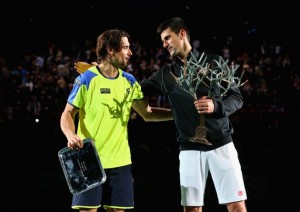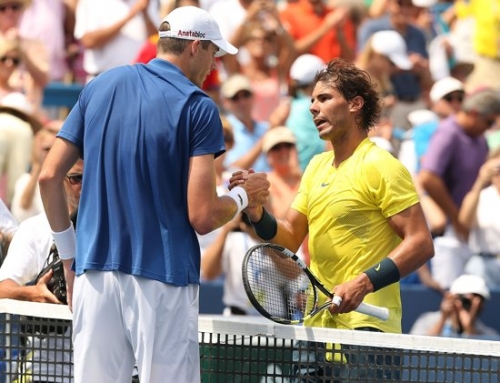 Most players find the time after the US Open difficult. They’ve given their best up to the US Open, but lag afterwards. There are some exceptions. Roger Federer generally plays decently well after the US Open, though he does schedule a fair bit of rest before Shanghai. The other big exception is Novak Djokovic. Nearly every year, he comes into the post US Open run and plays exceptionally well. There was only one year, ironically his best year, 2011, where he didn’t play well, and that was due to an injury.
Most players find the time after the US Open difficult. They’ve given their best up to the US Open, but lag afterwards. There are some exceptions. Roger Federer generally plays decently well after the US Open, though he does schedule a fair bit of rest before Shanghai. The other big exception is Novak Djokovic. Nearly every year, he comes into the post US Open run and plays exceptionally well. There was only one year, ironically his best year, 2011, where he didn’t play well, and that was due to an injury.
Players have long complained the off-season isn’t long enough. Tennis used to play closer to 11 months a year with tournaments run past Thanksgiving (the US version in late November). The ATP Tour sought to rectify this by removing an open week between Paris and London.
Only, one problem with this. Most players want to play well at the year-end championship. Even though Paris is a Masters 1000 event, London is bigger. Every win in the round robin is almost an ATP 250 tour win (200 points per win). You can pick up 3/4 of a Slam by going undefeated.
Last year was the first year of the modified schedule, and you saw player after player lose early. Djokovic, Tipsarevic, Berdych, Murray, del Potro. Federer didn’t even bother to show up. While this lead to one of the more intriguing tennis storylines of the year, the rise of Jerzy Janowicz, it didn’t speak well for the tournament.
Who knows what happened between last year and this year, but the players seemed more motivated to win. Nowhere was this more evident than the eight quarterfinalists who, coincidentally, were also the eight qualifiers for the year-end championship.
One concession to the players appears to be the scheduling. Historically, one round robin group (of 4 players each) plays one day, then the other round robin group plays the next day. Typically, the top and bottom players play that first round, and the middle two players play the other match.
The problem, of course, was that a finalist at Paris might have to play a tough match the next day, after more than likely having played several days in a row.
This year, they decided to play the four semifinalists (Djokovic, Federer, Nadal, Ferrer) on Day 2 which, this year, falls on a Tuesday. That would give the finalists (Djokovic and Ferrer) a day of rest (a day and a half if you count the tournament final being held in the afternoon)..
Which brings us to the Paris final.
It looked like, for all the world, that it would be another Djokovic-Nadal final. Nadal would have been seeking his sixth Masters 1000 title of the year, which would set a record, and Djokovic was looking to maintain his unbeaten streak since the US Open.
Only, it didn’t work out that way. Defending champ, David Ferrer, channeled his ultra-aggression that he used in the French Open and duelled his way to a win.
Because Ferrer is, frankly, one of the shorter players on tour, and because he lacks the kind of pure pace, many think of him as a strict counter-puncher, someone who fetches balls and fetches balls. While Ferrer is capable of doing that, in this day and age, you can’t win without a level of aggression, and Ferrer is always looking to be more aggressive, even if he doesn’t hit the outright winner.
Against Nadal, Ferrer attacked a fair bit to the Nadal backhand, hoping to open up the inside-out forehand, which he was hitting imperiously. Nadal, for his part, looked a bit off. He let Ferrer dictate points. Ferrer, to his credit, played smartly, even using a favorite Nadal strategy–coming to net when the opponent is slicing their backhand, to win a few nice points at net.
Ferrer had a break early in the first set and was able to hold that break to win the first set. He opened up the second set in similar fashion with a break, but Nadal broke back as Ferrer attempted to serve for the set at 5-4. Fans of Ferrer perhaps gasped thinking that Ferrer would collapse and lose the match in 3 sets.
But, it didn’t happen. Instead, Ferrer managed to break again, and this time, he closed out the set and match to one of his rare wins over Nadal.
In the other semi, Federer had finally won a match over a top ten player, something he hadn’t done since the start of the year. Federer beat del Potro in three sets in the quarterfinal, showing that his game is picking up. But could he beat Djokovic who, by now, had beaten Federer several times in a row.
Federer was able to take advantage of a strangely inconsistent Djokovic, who kept misfiring his groundstrokes and double-faulting, and his change of pace, using his slice more than he typically does, as well as coming to net more than usual, to fashion a first set win. However, it felt like it was a matter of time before Djokovic stopped making errors, and Federer would start making his own, and that’s what happened. Djokovic came back to win 46 63 62.
The finals must have been frustrating for Ferrer who basically did the same thing in both sets. He had an early break, then got broken back, and broken a second time, to lose both sets 75 75. It is such a tough ask for a player to beat both Djokovic and Nadal in the same tournament, especially as they are the number 1 and 2 player in the world.
This week, the year-end championships. Nadal appears all but certain to end the year at number 1. Djokovic trails Nadal by about 1420 points. At best, he can only win 1500 points by going undefeated. Nadal just needs one match win in the round robin to end as number 1. Djokovic can close the gap to about 1000 points with some good play, but he’s also the defending Australian Open champ where Nadal has zero points, so it may be a while before Djokovic can start to close that gap.



![[Shanghai] Djokovic wins the China double, adding Shanghai title to Beijing](https://www.essentialtennis.com/wp-content/uploads/2013/10/20131013nole-500x383.jpg)
![[Shanghai, SF] del Potro upsets Nadal in awesome display of power](https://www.essentialtennis.com/wp-content/uploads/2013/10/20131012delpo-500x383.jpg)

![[Cincinnati] Nadal wins 26th Masters 1000 title with win over Isner 7-6, 7-6](https://www.essentialtennis.com/wp-content/uploads/2013/08/20130818rafa-500x383.jpg)
![[Montreal] Nadal crushes Raonic to win 25th Masters 1000 title](https://www.essentialtennis.com/wp-content/uploads/2013/08/20130811nadal-500x383.jpg)